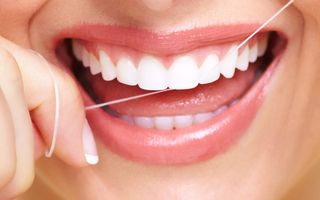
Dentist in Sydney tells you how to floss correctly
Dentist in Sydney tells you how to floss correctly
- In spite of the importance of flossing, less than 10% of the population performs this technique regularly. The use of dental floss, is useful in cleaning between the teeth where the toothbrush bristles cannot reach. To floss correctly, the following steps may be helpful:
- Break off about 45 cm of floss and wind most of it around the middle finger of one hand and the rest around the other middle finger.
- Hold the floss between the thumbs and forefingers and gently guide and rub it back and forth between the teeth. When it reaches the gum line, the floss should be curved around each tooth and slid gently back and forth against the gum.
- Finally, rub gently up and down against the tooth. Repeat with each tooth, including the outside of the back teeth. If, on repeated flossing attempts, the floss becomes shredded or cannot be removed easily from between the teeth, a rough crown or overhanging filling may be the cause. In such cases, the restoration should be redone. Such areas create spaces for the collection of food debris, plaque, and calculus.
Seven most common flossing mistakes
- Never Flossing: It is surprising how many people never floss! Flossing is every bit as important as brushing. Although it is true some people live a lifetime without flossing and still manage to keep their teeth, the average person will begin to lose teeth in mid to later life to gum disease unless they floss.
- Not flossing often enough: To be effective, flossing should be done daily. Missing a day or two is no major disaster, but calculus (tartar) can begin to form in as few as two to four days.
- Not removing plaque with the floss: Some people have the misguided notion that floss is primarily to remove food particles. If meat gets caught, they use floss to get it out. Although floss works well to remove food, its primary function is to remove plaque, the invisible film of bacteria that is constantly forming on and in between teeth. Instead of merely popping the floss between the teeth to loosen food, the floss should be used to scrape the tooth surface clean of plaque.
- Not flossing both teeth: Every time you pop the floss between two teeth, you must floss both teeth individually.
In other words, first you must push against one tooth, and then pull against the other tooth. It is not effective to quickly pop the floss in and out of each space. - Not flossing underneath the gum line: The floss should be gently placed all the way under the gum (it shouldn’t hurt) since the gum line is the most important area to clean.
- Not flossing with sufficient pressure: It takes a fair amount of scraping to dislodge plaque. The floss should be pressed firmly against the tooth surface and scraped up and down along the long axis of the tooth (not back and forth as if one were shining shoes with a buff cloth). If you are pressing hard enough you will hear a squeaking sound. That’s good – you’re getting the tooth ‘squeaky clean’.
- Not flossing long enough: To do a thorough job, you should count about ten up and down strokes on each tooth.
These can be rapid short strokes and won’t take longer than a couple of seconds per tooth. But since most people have about 28 teeth, it would take most people no less than two minutes to do a good job.Two minutes is a long time – but the reward of investing those two minutes each day is a healthy, clean set of teeth that will last a lifetime.
Dr. David Osie recommends the Reach Waxed Whitening Mint flossSpecial triangular toothpicks, such as Sensodyne Interdens Fine, may be effective for spaces between teeth especially if you have never flossed or can’t floss. Moisten before use and allow softening a little. Standard round toothpicks should never be used for regular hygiene.The first few days you use floss, toothpicks or Curaprox correctly you can expect quite a lot of bleeding. Be assured this will rapidly improve and not return if you don’t miss too many times!


